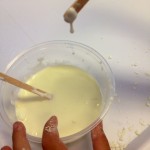We wanted to start the year off by focusing on “thinking like scientists,” so Mrs. C (our science teacher) had kids experience oobleck and its wonderful, surprising qualities. Is it a liquid or solid? Working in table teams, students explored this substance, which sometimes had liquid properties (flowing in the hand) and other times solid (balling up into little solid bits).
In addition to making guesses as to what it was, teams also came up with words and descriptions for what they thought this mystery substance was.
If you want to experience oobleck at home, here’s a resource:
http://www.scientificamerican.com/article/oobleck-bring-science-home/
As we delved into the scientific method of inquiry, we were simultaneously studying about the brain. The brain’s is able to form new pathways when we learn new things, which is why challenging ourselves makes us smarter! This is called neuroplasticity.
http://easyscienceforkids.com/all-about-your-amazing-brain/
Combining measurement and reaction times, pairs of students were challenged to give each other the “ruler test.” You hold your hand out. Your partner holds a meter stick between your fingers, with the end just at the top of your fingers. Your partner releases the meter stick and you grasp it as quickly as possible, noting how many centimeters your reaction time measured.
Scientists are careful observers and take notes to record their findings. In order for the data to be interpretable by the global community, findings are recorded using the metric system (centimeters/meters, milliliters/liters…).
Scientists around the world are well-aware that things don’t always go according to plan…
Teaching the metric system to young children isn’t easy, since most kids here in the US have not had exposure to it, let alone experience with it. So, in more measuring fun, we moved on to volume…
Our young scientists gathered experience with milliliters (1,000/liter) using syringes and graduated cylinders. Mrs. C. taught us about the meniscus, the curve in the upper surface of a liquid, which makes it challenging to measure the volume correctly. The lowest part of a concave meniscus is where scientists measure the water level. Mrs. C. encouraged students to get eye-level with the graduated cylinder in order to read the water level correctly.
We will continue to think as scientists throughout the year; measuring carefully, observing closely, recording accurately, and learning a great deal along the way!


















